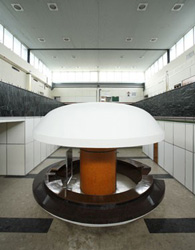
Image from Wallpaper
Anyone who has spent any length of time in Singapore will tell you that it’s a country in a hurry. Blink and a building along the main shopping stretch of Orchard Road disappears and the next day, a massive retail and residential development begins rearing up a complex algorithm of steel girders.
Of course, the speed of this activity is a source of considerable distress for architects and conservationists as a great many architecturally important buildings – some barely thirty or forty years old – have been demolished or threatened (W*108); but with land prices in Singapore already on par with New York and London, foolish is the developer who hesitates.
All of which makes the old Paya Lebar airport such an interesting time-capsule; for, here, roughly seven miles north east of the city centre’s ever changing profile of skyscrapers, is a perfectly preserved relic from a not so distant past when Singapore was still a subject of Great Britain.
The first commercial airport was built in 1937 at Kallang. Though it was, at the time, hailed as the finest airport in the British empire, it eventually became clear that the small runway was unable to handle the growing volume (and weight) of air-transport as the smaller fleets of Hawker Ospreys and Daks gave way to the bigger, more modern four-engined Constellations and DC-4 Skymasters.
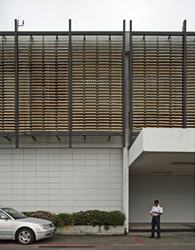
Image from Wallpaper
The solution was found at Paya Lebar, a few miles north of Kallang, on a site bounded by rubber and coconut plantations, swampland and hilly ground. The airport – designed by K.A. Brundle and L. Carpenter from the Public Works Department – was officially opened in August 1955. Over the next quarter century, new terminals and extensions were built to cope with the ever increasing volume of visitors. A futuristic octagonal control tower was added in 1960.
But from the start, Paya Lebar was, in every way, a stark departure from Kallang. Where the latter was a glorious, curvaceous Art Décor pile, Paya Lebar was an aggressively sleek creature, all haughty in its low-slung modernist right angles.
The arrival hall, for instance, was a long box-shaped building with a relatively small entrance that, like the TARDIS, opened into a light-washed double-volumed space where the high ceiling was held aloft by thick pillars sheathed with white-veined black marble and muted gold mosaic tiles. Floating dog-leg staircases on both ends of the hall led up to a viewing gallery dominated by a ravishing mosaic mural depicting the Singaporean waterfront at night. Indeed, the airport, wrapped up in the glamour of travel of the time, was a popular backdrop for movies, most famously Peter Bogdanovich’s seamy exposé Saint Jack.
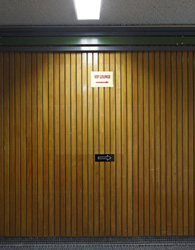 Image from Wallpaper
Image from WallpaperArchitect Simon Chai is particularly enamoured by Paya Lebar’s potent symbolism of a certain time and aesthetic. ‘Many of the airport’s functional and decorative features were ground-breaking for Singapore at the time and they’ve been further developed only in recent years in commercial buildings,’ he says. ‘Given the intense sunshine in the tropics and that air-conditioning only came much later, I really admire its façade of sun-shading of rich mellow bronzed aluminum. What’s also very striking is that it really was one of the very few Modern public buildings that was very accessible to the ordinary Joe.’
But even Utopian dreams come to an end. By the early 1970s, Paya Lebar had become the Heathrow of its day: congested, slow and an ordeal to navigate. In 1960, it was processing over 300,000 passengers and 30,000 aircraft movements. Ten years later, the numbers had streaked up to 1.7m and 51,000 respectively. In a constant state of repair, the single runway was simply unable to cope as planes were kept in interminable holding patterns as ground crew scrambled to unload aircraft and passengers. Worse, there were never enough parking bays for the Boeing 747s, Concorde and McDonnell Douglas DC-10s. Even the construction of a more spacious arrival building in 1978 was a stop-gap measure.
Expansion was not a viable option: Though a second runway was desperately needed, this would have involved diverting a river and increasing air-traffic over heavily populated residential areas. Says Lim Chin Beng, then the director of administration of the fledgling Malaysia-Singapore Airlines, ‘It was very clear we needed a new airport. Paya Lebar had runway capacity, but that wasn’t the problem. The huge traffic was.’ In 1981, the ever practical government decamped to Changi – where it’s collected laurels for the world’s best airport ever since – leaving Paya Lebar to the flyboys at the RSAF (Republic of Singapore Air Force), the new tenants.
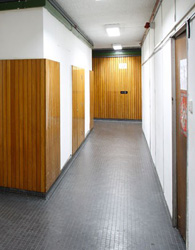 Image from Wallpaper
Image from WallpaperSince then, security has remained tight and access to the public completely cut off, as Wallpaper* discovered when we secured special clearance to visit in February. But during our tour, it became evident that the confluence of history and circumstance has kept the airport and all its bold architecture practically frozen in a time-warp.
The departure hall now houses air-force units like a flight test centre; the arrival hall has been sectioned off into offices, storage and recreational rooms; while the hangers house the ops units. But even though make-shift plasterboard walls now mar the spaces, everything is functionally intact right down to the gold-mosaic pillars, black and white chequered floor tiles, and the Kubrick-esque mushroom-shaped information counter.
Architect and historian Dinesh Naidu marvels that Paya Lebar has been so well preserved, especially since Singapore has so few buildings left from the 1950s and 1960s. ‘When we talk about interesting buildings from that period, Paya Lebar is not the first thing to come to mind simply because it’s completely out of sight. It’s been a military base for nearly thirty years now and so it’s never been subjected to the kind of radical alteration that a commercial building probably would have been. For Singapore, that’s very rare.’ In a country where the architectural imprint is constantly shifting, Paya Lebar is a rare glimpse into the recent past. A more romantic past to be sure, but one whose features are, as Simon Chai notes, starting to find relevance again. Even if – for now at least – no one gets to see it.
The article is republished with permission from Wallpaper.com











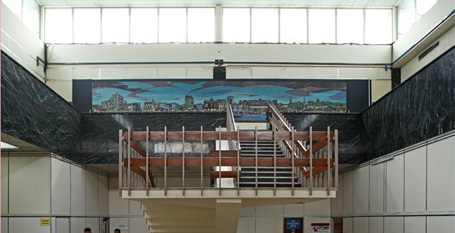
 打印版本
打印版本















读者回应
Nice photos too. Very retro. :)
no wonder people had to check in 2-3hrs last time.
thanks for repro this article.
Go check out ...
http://www.youtube.com/watch?v=tJ2wx38piIw&feature=player_embedded
The orange coloured information desk is featured at about 0:10 to 0:16 in the movie clip, from the 1979 film, Saint Jack, directed by Peter Bogdanovich. This film rewrote Singapore as a supposedly sleazy locale. Given that the Singaporean authorities would never sanction a film like this, Peter Bogdanovich submitted a script which had been specially "rewritten" with all the contentious elements removed- in order to appear kosher for the authorities. Understandably, the movie was banned in Singapore at the time.
The symbolism of what used to be there serves as a reminder of the people who used to live/ work. The structural purpose of the Architecture and the cantilevering staircase serves only the people within. I am sure that images of flamboyant air hostesses in pastel-coloured-polyester-suits with natty hairdos will come to mind readily for some.
The nostalgia can be fun.
On a totally different topic, there is a similar issue with the heritage and nostalgic architecture of Pearl Bank Apartments near Outram Park MRT. En-block-sales were threatening good architecture and the place of heritage.
Go refer to:
1. http://maps.google.com.sg/?ie=UTF8&ll=1.2826,103.840633&spn=0.002542,0.004812&t=h&z=18
2. http://www.pearlbankapartments.com/
The use of black marble is really elegant too, so german pavillion-ish.
Makes you hate contemporary architecutre which is so confused.
请先登入再使用此功能。